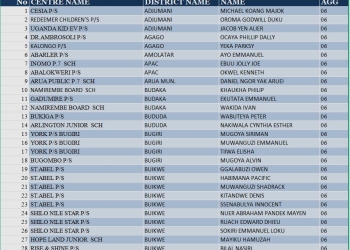Air expansion is a natural phenomenon that occurs when air is heated, causing the molecules to move apart, resulting in increased volume and decreased density. Though often invisible and overlooked, air expansion significantly influences weather patterns, agriculture, human health, infrastructure, and disaster risk, especially in regions that experience dramatic temperature fluctuations and varying altitudes. Kasese District in Western Uganda exemplifies such a region. The interplay of its unique topography, equatorial location, and climatic variations makes it an ideal case for examining the impacts of air expansion on both the environment and the local population.
Kasese lies within the western rift valley and borders the Democratic Republic of Congo. It features a remarkable range of elevation, from the low-lying plains near Lake George to the towering Rwenzori Mountains, which rise to over 5,000 meters above sea level. This geographical diversity contributes to stark microclimatic variations. The lower areas tend to be hotter and drier, while the mountainous regions experience cooler temperatures and heavier rainfall. These contrasts create conditions in which air expands and contracts frequently, affecting atmospheric pressure and contributing to sudden and sometimes severe weather events.
The underlying science of air expansion can be traced to thermodynamics, particularly Charles’s Law, which states that the volume of a gas is directly proportional to its temperature when pressure remains constant. In practice, this means that as temperatures increase, air expands and becomes lighter, causing it to rise and create low-pressure systems. These systems can generate wind, draw in moisture, and influence precipitation patterns. In Kasese, this process often plays out during the dry seasons when intense daytime heat causes widespread air expansion, followed by episodes of stormy weather due to the sudden influx of cooler air from the mountains.
In recent years, Kasese District has witnessed increasing weather instability, a trend closely linked to the dynamics of air expansion. Heatwaves have become more frequent and intense, especially in sub-counties such as Karusandara and Hima. These conditions often culminate in abrupt windstorms and localized turbulence, leading to property damage, loss of crops, and disruption of livelihoods. For instance, in 2022, several communities reported strong winds and roof damage after days of unusually high temperatures. Local weather stations recorded significant drops in air pressure, reinforcing the connection between temperature-induced air expansion and storm formation.
Agriculture, which supports the majority of Kasese’s population, is especially sensitive to these shifts. The district’s farmers rely heavily on predictable rainfall and moderate temperatures for planting and harvesting crops such as maize, beans, cassava, and coffee. However, during periods of extended heat, the air becomes too dry to support cloud formation, delaying rains and causing soil moisture to evaporate. This disruption in seasonal cycles can devastate crop yields. In 2023, coffee farmers in the highland areas of Maliba and Kilembe reported reduced flowering and fruiting due to persistent dry conditions and warm nights. Agronomists linked these outcomes to the prolonged effects of air expansion, which not only disrupted rainfall but also affected the delicate temperature thresholds required for crop development.
Beyond agriculture, the health of residents in Kasese is also at risk due to changes in air behavior. As air expands and temperatures rise, human bodies struggle to regulate heat, leading to an increased incidence of heat stress, dehydration, and related complications. Health centers in the region have noted spikes in cases of dizziness, fatigue, and respiratory ailments during the hotter months. Expanded warm air tends to trap pollutants and particulate matter closer to the ground, particularly in densely populated areas such as Kasese Municipality. This results in poor air quality and heightened vulnerability for people with respiratory conditions like asthma and bronchitis. Additionally, rising temperatures linked to air expansion contribute to the proliferation of disease vectors such as mosquitoes. The warmer environment accelerates breeding cycles and extends the transmission period of diseases like malaria and dengue fever.
Kasese’s infrastructure also faces the adverse effects of temperature-driven air expansion. Roads, bridges, and buildings are designed based on standard temperature and load assumptions, but as climate variability intensifies, these assumptions are often exceeded. Materials like asphalt and concrete expand when exposed to prolonged heat, leading to cracking, warping, and structural degradation. One notable example is the recurring damage observed along the Kilembe Mines Road. During hot seasons, the road surface has frequently shown signs of buckling and stress fractures. Engineers attributed these problems to thermal expansion exacerbated by the district’s rising temperatures. Public buildings, including schools and health centres, also require more maintenance due to expanding and contracting materials, which weaken joints and cause leaks or collapses over time.
Moreover, air expansion plays a hidden yet critical role in amplifying natural disasters such as floods and landslides. When hot air masses expand and absorb large amounts of moisture, they eventually cool, often rapidly, especially when they rise toward the Rwenzori highlands. This cooling causes condensation and leads to intense rainfall in a short duration. The resulting downpours can overwhelm rivers, destroy crops, and displace thousands of people. In May 2020, Kasese District experienced one of its most destructive floods in recent memory, following a heat spell that culminated in heavy rain. The Nyamwamba and Mubuku rivers burst their banks, destroying homes, roads, and bridges. Experts linked the rainfall to the sudden condensation of previously expanded, moisture-saturated air masses.
In response to these multifaceted impacts, stakeholders in Kasese have initiated several adaptation measures. One key effort has been the expansion of meteorological monitoring by the Uganda National Meteorological Authority. Weather stations installed across the district collect data on atmospheric pressure, temperature, and humidity to improve forecasting accuracy. This data is disseminated through radio programs, community meetings, and SMS alerts to help residents prepare for extreme weather. These early warning systems have helped reduce loss of life and property in recent years, although access and reliability remain challenges in some remote communities.
Community-based education initiatives have also gained traction. CECIC, often in collaboration with district authorities, are working to increase public awareness about the science of air behaviour and its practical consequences. Workshops, school programs, and public forums are used to explain how air expansion affects everyday life and to promote adaptive strategies. Residents are being encouraged to adopt measures such as constructing energy-efficient homes, planting shade trees, and using water harvesting techniques to manage temperature and rainfall variability.
Infrastructure development is gradually evolving to address the realities of a warming climate. New road construction projects include expansion joints and use materials that are more resistant to thermal stress. Architects and engineers are also rethinking building designs to enhance natural ventilation and reduce the accumulation of heat indoors. In rural areas, locally available materials such as mud bricks and thatch are regaining popularity due to their better thermal performance compared to cement-based structures.
In agriculture, climate-smart practices are being promoted through farmer field schools and extension services. These include the use of drought-tolerant seed varieties, soil conservation methods such as terracing, and the adoption of small-scale irrigation systems to sustain crops during dry spells. Farmers are also being trained to diversify their crops and income sources to build resilience against climate-induced shocks.
Despite these advancements, significant obstacles remain. The availability of long-term climate data is limited, making it difficult to identify trends and design comprehensive adaptation plans. Funding for climate resilience projects is often insufficient, leading to a reliance on external donors whose support may not always align with local priorities. Furthermore, community engagement efforts face barriers such as illiteracy, cultural resistance, and logistical challenges in reaching remote populations. Environmental degradation, particularly deforestation and wetland encroachment, continues to reduce the district’s natural capacity to moderate climatic extremes.
To address these challenges more effectively, Kasese District requires a strategic and well-coordinated approach. Expanding the network of meteorological stations and ensuring they are well-maintained and accessible is crucial. Educational institutions should incorporate climate and environmental studies into their curricula to foster a scientifically literate population. At the same time, partnerships with universities and research institutions can facilitate localized studies on the district’s climate dynamics, including the role of air expansion.
Infrastructural resilience must be prioritized in public investment strategies, with emphasis on building codes that account for thermal stress and climate variability. Urban and rural development plans should include provisions for green spaces, sustainable drainage systems, and improved building orientation to reduce heat retention. Strengthening policy implementation, especially in areas related to land use, environmental protection, and disaster risk reduction, will ensure that adaptation measures are not undermined by conflicting practices or lack of enforcement.
Agricultural resilience can be improved by integrating climate information services with market access and financial tools such as micro-insurance and weather-indexed loans. These innovations help farmers manage risk while encouraging long-term investment in sustainable practices. Policymakers must also support women and youth, who are key players in agriculture and community development, by ensuring that adaptation programs are inclusive and equitable.
The phenomenon of air expansion, though largely unseen, exerts a powerful influence over the lives and livelihoods of people in Kasese District. Its impacts reverberate through every sector from weather patterns and crop performance to health outcomes and infrastructure durability. As climate change continues to intensify, the effects of air expansion will become more pronounced and complex. By combining scientific understanding, local knowledge, and coordinated action, Kasese can build the resilience needed to adapt to these changes and thrive in a challenging but navigable future.

















